The highly anticipated OnePlus 13 is set to arrive with a leap in performance, sporting the new Snapdragon 8 Elite chipset, which may drive up its price compared to previous models. This next-gen processor promises improved processing power, graphics, and efficiency but could come at a premium. Here’s a detailed look at what to expect from the OnePlus 13, including how the Snapdragon 8 Elite could be influencing the price.

Why the Snapdragon 8 Elite Is Raising the Stakes – and the Price
The Snapdragon 8 Elite is Qualcomm’s latest offering, designed specifically to elevate the flagship experience. Built on a 4nm architecture, it promises up to 30% higher performance with a 20% boost in power efficiency. This processor not only enhances multitasking and app performance but also enables richer graphics and seamless AI capabilities, factors that appeal to users looking for a top-tier device. Here’s how this new processor impacts the OnePlus 13’s performance:
- Enhanced Gaming Experience: With higher GPU performance, the Snapdragon 8 Elite will make mobile gaming smoother with high frame rates and advanced graphics.
- Improved AI Capabilities: From photo enhancements to personalized suggestions, the processor’s AI engine can handle more complex algorithms, enriching the user experience.
- Battery Optimization: The advanced efficiency of the 8 Elite helps extend battery life, even under heavy use, which makes it ideal for power users.
However, with this high-performing processor,manufacturing costs rise, and the retail price likely follows.
Expected Price of the OnePlus 13
OnePlus has consistently positioned itself as a “flagship killer,” but recent models have shown a gradual shift toward premium pricing. With the anticipated upgrades, the OnePlus 13 could start around $800 or higher, representing an increase from previous generations. This makes it comparable to other top-tier smartphones from brands like Samsung and Apple, although likely still undercutting them in price.
Key Specifications and Features of the OnePlus 13
1. Design and Display
- Build Material: A premium glass and metal build is expected, with a sleek, refined design.
- Screen: The OnePlus 13 will feature a 6.7-inch AMOLED display with a 2K resolution, offering rich colors and deeper contrasts.
- Refresh Rate: The device will likely support a 120Hz refresh rate, making scrolling and animations fluid and responsive.
2. Camera System
- Main Camera: A triple-camera setup with a 50MP main sensor, optimized for low-light photography.
- Ultra-Wide & Telephoto Lenses: An ultra-wide lens and a telephoto option with 5x optical zoom.
- Selfie Camera: Expected to feature a 32MP front-facing camera for high-quality selfies.
3. Battery and Charging
- Battery Capacity: A 5,000mAh battery with improved endurance, leveraging the Snapdragon 8 Elite’s efficiency.
- Charging: Support for 100W wired charging and 50W wireless charging.
4. Storage and RAM
- Variants: Options are expected for 8GB/12GB of RAM and 256GB/512GB storage configurations.
- No Expandable Storage: Following the trend of previous models, the OnePlus 13 is unlikely to have microSD support.
5. Software and Features
- Operating System: The OnePlus 13 will launch with OxygenOS based on Android 14, featuring streamlined design elements and intuitive gestures.
- Enhanced Privacy and Security: Improved privacy features in Android 14 paired with OnePlus’ security enhancements.
Final Thoughts on the OnePlus 13
The OnePlus 13 is shaping up to be a powerhouse device, with the Snapdragon 8 Elite adding considerable value but also likely contributing to a higher price. The combination of enhanced performance, premium design, and flagship-level specs makes the OnePlus 13 a compelling option for those looking for a high-performance Android device.





